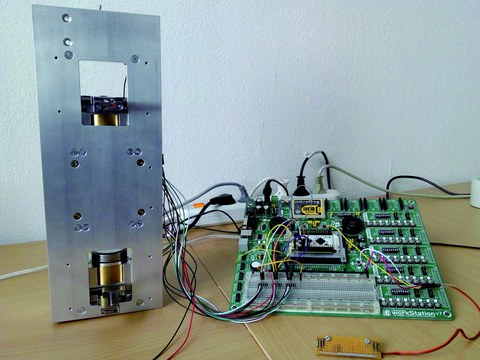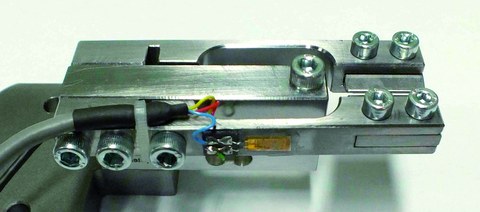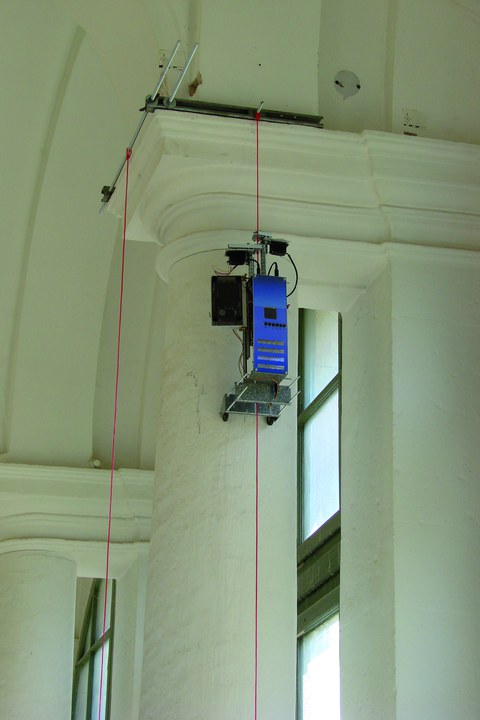Development of a climbing robot at linear guidances for building inspection
Table of contents
Project data
|
Titel | Title |
Report in the yearbook 2014
Robots for building monitoring

Robot with electronic test bed
Increasingly, robots equipped with sensors and cameras are set into operation to gather data for building reconstruction and rehabilitation projects. In the process, even complete scans of difficult to reach surfaces are feasible.
Within this background, the robot „CLIBOT“ was designed and constructed as an experimental model during a project promoted by the AiF. The robot can move thru ropes, wires and strands towards its desired location to take photos of desired areas. CLIBOT was completed in 2014, and it has demonstrated its capabilities.
Basically, the objective was to develop a gripper for a climbing robot that grasps the climbing media safely and has low energy consumption. An optimal design was found by specialized tests. The basic device consists of two grippers, which are moving alternatively up and down by a driving motor. Further, the driving motor causes an opening and closing of the grippers, so that a climbing process can be executed, like that in a climbing rope action.
The rapid developing rate of smartphones, with their excellent optic, high performance and low dimensions, predestine these devices for robot operation and control. The robot electronic consists of a 5-inch android mobile phone with a special interface aka „IOIO“. A dedicated android application executes the „brainpower“, which controls the robot kinematics and delivers a real-time image of the internal camera via WLAN. That software enables setup and adapts the configuration to the operational conditions.
The data and command interchange by wireless LAN allows a convenient remote control by using all phones, tablets and notebooks. The installed web browser displays the front-end of the robot including a real-time image, and it transmits commands to the CLIBOT with the purpose of robot control and picture taking. The displayed live image, that shows the actually crossed surface, eases the precise movement towards monitored places, even under construction site conditions.
Report in the yearbook 2013
Robots for Building Monitoring

Test gripper.
Equipped with sensors and cameras, robots are increasingly used to gather data for building reconstruction or reusing purposes. In the meantime, even complete scans of hardly accessible surfaces are possible. Against this background, we participate in a project that has been supported by the AiF since last year. It is the aim to enhance the robot CLIBOT, which has already been created as a „proof of concept“ and which can climb on ropes, wires or strands to its site of operation. Eventually, a demonstrator that is suitable for industrial production shall be developed.
Basically, a gripper for a climbing robot that grasps the climbing media very firmly, maintains its position without gliding and high energy consumption and avoids leaving the rope for safety reasons has to be developed. Our project partner FAD realized a prototype of such a gripper and a test stand for the determination of necessary gripping forces. Our institute determined the parameters necessary for the gripper design and production. Apart from this, we have developed suitable methods to fix ropes at surfaces so that the robot can easy climb pillars, arched roofs or underneath bridges.
The kinematic concept of this robot was designed under consideration of this newly developed gripper and is now produced. The new robot will be more robust, independent of weather conditions and able to reach hard accessible places with higher reliability.
The robot will be controlled with a mobile phone. Excellent haptic, high performance and tiny dimensions predestine these devices for robotics. A 7-inch tablet and optionally a notebook serve as remote control. A smart phone, integrated into the robot, controls its movement and the grippers and transmits a live image of the integrated camera via WLAN. This phone enables the versatile configuration of the software, hardware and wireless communication. The robot mobile phone - and thus the robot - is remotely controlled by a tablet via Bluetooth from the ground. The live image shows the surface passed by the robot and facilitates its precise movement to monitored places even under construction site conditions.
Report in the yearbook 2012
Robots Getting to Everywhere

CLIBOT in the Dresden Zwinger
In the last two or three decades mobile robots have rapidly developed. To mars or to the depths of the oceans, to the subterranean world of channels, the inner parts of humans – nothing is out of reach, all can be inspected.
For civil engineering purposes it would be desirable to have robots, equipped with sensors and cameras, which can climb autonomously at buildings or bridges and can so enable an inspection of supports, coatings and other hardly accessible points. By such robots could be gathered data for planning of restoration, reconstruction or reusing in a costly way.
Hence a test version of this robot was developed that can climb at ropes, wires, pipes or columns to the inspection site. The device grips the climbing media with arms and claws and moves up and down. A battery delivers the energy. The interaction of grasping and releasing the rope and the appropriate arm movements – that reminds of rope climbing in school sports – is controlled by a microcontroller. The movement instructions for up and down climbing were transmitted to the processor by a remote control.
Currently the robot was always used for visual building inspection wherefore it was equipped with a camera. Their live image was radio transmitted. On the one hand the robot could be positioned in that way and on the other hand photos of the visited building surface could be shot to evaluate their condition.
With this test version of the robot we could demonstrate the efficient ability to safely reach all inner and outer surfaces of a building and their reliable data acquisition. The existing results were so promising that a further development of an industrial prototype as well as the improvements of grasping principle and the equipment with sensors would be desirable. In summer 2012 an application for subventions was filed to the AiF together with a competent company in Dresden and was meanwhile granted. Within the next two years we hope to achieve further improvements up to the industrial application of that climbing robot.
